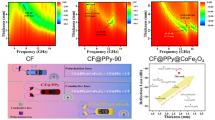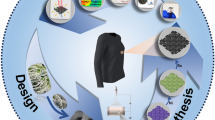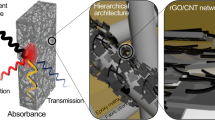Abstract
With the rapid development of 5G communication and artificial intelligence (AI) technology, electromagnetic radiation pollution is emerging as a serious issue. Achieving both uniform dispersion and controllable loading of absorbers and obtaining functional wearable absorbers with high electromagnetic response are still considered great challenges. In this work, a flexible fiber-based absorber (VFT2h/MF/PPy) with a rich interfacial polarization relaxation was obtained by integrating heterostructures and performing nanostructure design and introducing π-conjugated polymer components. Electrons migrated and redistributed between nanoparticles and nitrogen-carbon lattices with different electrostatic states. The formed heterogeneous interface promoted the electromagnetic attenuation response in the high-frequency region. More specifically, the effective absorption frequency bandwidth was up to 5.6 GHz (corresponds to the Ku-band with a matching thickness range up to 2.55–4.85 mm). Impressively, the abundant modification sites on the fiber surface adjusted the content and dispersion of the magnetic nanoparticles and enhanced the vector superposition effect generated by the structural distribution of the magnetic/electric fields. The introduction of dielectric components improved the interfacial polarization strength of the heterojunction surface and the synergistic effect of the dipolar polarization. The high-efficiency electromagnetic attenuation performance was attributed to multiple loss mechanisms. Our work provides a reference path for the microscopic regulation of the high-efficiency electromagnetic response mechanism of fiber-based flexible absorbing materials.
Graphical Abstract









Similar content being viewed by others
Data availability
All data are available upon reasonable request.
References
Lv HL, Yang ZH, Pan HG, Wu RB. Electromagnetic absorption materials: current progress and new frontiers. Prog Mater Sci. 2022;127: 100946.
Fan XC, Xu ZC, Wang JP, Wang H, Wei H, Wang Q, Wang CG, Shen Q. Constructing magnetic iron-based core-shell structure and dielectric nitrogen-doped reduced graphene oxide nanocomposite for enhanced microwave absorption performance. Appl Surf Sci. 2023;607: 155013.
Zhao J, Gu Z, Zhang QG. Stacking MoS2 flower-like microspheres on pomelo peels-derived porous carbon nanosheets for high-efficient X-band electromagnetic wave absorption. Nano Res. 2023. https://doi.org/10.1007/s12274-023-6090-3.
Jiang ZY, Gao YJ, Pan ZH, Zhang MM, Guo JH, Zhang JW, Gong CH. Pomegranate-like ATO/SiO2 microspheres for efficient microwave absorption in wide temperature spectrum. J Mater Sci Technol. 2024;174:195–203.
Cheng JY, Zhang HB, Ning MQ, Raza HS, Zhang DQ, Zheng GP, Zheng QB, Che RC. Emerging materials and designs for low- and multi-band electromagnetic wave absorbers: the search for dielectric and magnetic synergy? Adv Funct Mater. 2022;32:2200123.
Ma ZH, Liu HL, Luo ZK. A general method for the large-scale preparation of multifunctional magnetic Sm-Fe/Co nanomaterials. Adv Funct Mater. 2023. https://doi.org/10.1002/adfm.202301350.
Xu ZY, Zheng E, Xiao ZW, Shao HB, Liu YC, Wang JM. Photo-Initiated in situ synthesis of polypyrrole Fe-Coated porous silicon microspheres for High-performance Lithium-ion battery anodes. Chem Eng J. 2023;459: 141543.
Wei CH, Shi LZ, Li MQ, He MK, Li MJ, Jing XR, Liu PB, Gu JW. Hollow engineering of sandwich NC@Co/NC@MnO2 composites toward strong wideband electromagnetic wave attenuation. J Mater Sci Technol. 2024;175:194–203.
Liu PB, Gao S, Zhang GZ, Huang Y, You WB, Che RC. Hollow engineering to Co@N-doped carbon nanocages via synergistic protecting-etching strategy for ultrahigh microwave absorption. Adv Funct Mater. 2021;31:2102812.
Dai BS, Li JY, Liu XG, Wang N, Dai YX, Qi Y. Multiple synergistic losses in the absorption of electromagnetic waves by three-dimensional cross-linked carbon fiber. Carbon. 2022;195:308–18.
Zhang Y, Ruan KP, Zhou K, Gu JW. Controlled distributed Ti(3) C(2) T(x) hollow microspheres on thermally conductive polyimide composite films for excellent electromagnetic interference shielding. Adv Mater. 2023. https://doi.org/10.1002/adma.202211642.
Xu HX, He ZZ, Li Y, Wang YR, Zhang ZW, Dai XQ, Xiong ZM, Geng WC, Liu PB. Porous magnetic carbon spheres with adjustable magnetic-composition and synergistic effect for lightweight microwave absorption. Carbon. 2023;213: 118290.
Xue TT, Yang Y, Yu DY, Wali Q, Wang ZY, Cao XS, Fan W, Liu TX. 3D printed integrated gradient-conductive MXene/CNT/polyimide aerogel frames for electromagnetic interference shielding with ultra-low reflection. Nanomicro Lett. 2023;15:45.
Zhang S, Jia Z, Zhang Y, Wu GL. Electrospun Fe0.64Ni0.36/MXene/CNFs nanofibrous membranes with multicomponent heterostructures as flexible electromagnetic wave absorbers. Nano Res. 2022;16:3395–407.
Zeng ZH, Wang G, Wolan BF, Wu N, Wang CX, Zhao SY, Yue S, Li B, He WD, Liu JR, Lyding JW. Printable aligned single-walled carbon nanotube film with outstanding thermal conductivity and electromagnetic interference shielding performance. Nanomicro Lett. 2022;14:179.
Cui XJ, Jiang QR, Wang CS, Wang SH, Jiang ZY, Li XA, Deng DH. Encapsulating FeCo alloys by single layer graphene to enhance microwave absorption performance. Mater Today Nano. 2021;16: 100138.
Rao LJ, Wang L, Yang CD, Zhang RX, Zhang JC, Liang CY, Che RC. Confined diffusion strategy for customizing magnetic coupling spaces to enhance low-frequency electromagnetic wave absorption. Adv Funct Mater. 2023;33:2213258.
Ramamoorthy SK, Skrifvars M, Persson A. A review of natural fibers used in biocomposites: plant, animal and regenerated cellulose fibers. Polym Rev. 2015;55:107–62.
Jia XC, Li Y, Shen B, Zheng WG. Evaluation, fabrication and dynamic performance regulation of green EMI-shielding materials with low reflectivity: a review. Compos B Eng. 2022;233: 109652.
Song Y, Zhu RQ, Liu Z, Dai XY, Kong J. Phase-transformation nanoparticles synchronously boosting mechanical and electromagnetic performance of SiBCN ceramics. ACS Appl Mater Inter. 2023;15:4234–45.
Ling JQ, Zhai WT, Feng WW, Shen B, Zhang JF, Zheng WG. Facile preparation of lightweight microcellular polyetherimide/graphene composite foams for electromagnetic interference shielding. ACS Appl Mater Inter. 2013;5:2677–84.
Li E, Pan YM, Wang CF, Liu CT, Shen CY, Pan CF, Liu XH. Multifunctional and superhydrophobic cellulose composite paper for electromagnetic shielding, hydraulic triboelectric nanogenerator and Joule heating applications. Chem Eng J. 2021;420: 129864.
Xu HY, Li B, Jiang XY, Shi YN, Zhang X, Zhu CL, Zhang XT, Chen YJ. Fabrication of N−doped carbon nanotube/carbon fiber dendritic composites with abundant interfaces for electromagnetic wave absorption. Carbon. 2023;201:234–43.
Wang L, Ma ZL, Qiu H, Zhang YL, Yu Z, Gu JW. Significantly enhanced electromagnetic interference shielding performances of epoxy nanocomposites with long-range aligned lamellar structures. Nanomicro Lett. 2022;14:224.
Wang Y, Wang W, Xu R, Zhu MF, Yu D. Flexible, durable and thermal conducting thiol-modified rGO-WPU/cotton fabric for robust electromagnetic interference shielding. Chem Eng J. 2019;360:817–28.
An Q, Li D, Liao W, Liu T, Joralmon D, Li X, Zhao J. A novel ultra-wideband electromagnetic-wave-absorbing metastructure inspired by Bionic gyroid structures. Adv Mater. 2023. https://doi.org/10.1002/adma.202300659.
Lv HL, Yang ZH, Liu B, Wu GL, Lou ZC, Fei B, Wu RB. A flexible electromagnetic wave-electricity harvester. Nat Commun. 2021;12:834.
Ma JB, Zhao B, Xiang HM, Dai F-Z, Liu Y, Zhang R, Zhou YC. High-entropy spinel ferrites MFe2O4 (M = Mg, Mn, Fe Co, Ni, Cu, Zn) with tunable electromagnetic properties and strong microwave absorption. J Adv Ceram. 2022;11:754–68.
Thu TV, Van Nguyen T, Le XD, Le TS, Van Thuy V, Huy TQ, Truong QD. Graphene-MnFe2O4-polypyrrole ternary hybrids with synergistic effect for supercapacitor electrode. Electrochim Acta. 2019;314:151–60.
Trache D, Donnot A, Khimeche K, Benelmir R, Brosse N. Physico-chemical properties and thermal stability of microcrystalline cellulose isolated from Alfa fibres. Carbohydr Polym. 2014;104:223.
Wu T, Cai B, Wang JY, Zhang CG, Shi ZQ, Yang QL, Hu G-H, Xiong CX. TEMPO-oxidized cellulose nanofibril/layered double hydroxide nanocomposite films with improved hydrophobicity, flame retardancy and mechanical properties. Compos Sci Technol. 2019;171:111–7.
Jiang J, Chen H, Yu J, Liu L, Fan YM, Saito T, Isogai A. Rate-limited reaction in TEMPO/laccase/O(2) oxidation of cellulose. Macromol Rapid Commun. 2021;42:2000501.
Iwamoto S, Kai W, Isogai T, Saito T, Isogai A, Iwata T. Comparison study of TEMPO-analogous compounds on oxidation efficiency of wood cellulose for preparation of cellulose nanofibrils. Polym Degrad Stab. 2010;95:1394–8.
Wang Y, Wu XM, Zhang WZ, Huang S. One-pot synthesis of MnFe2O4 nanoparticles-decorated reduced graphene oxide for enhanced microwave absorption properties. Mater Technol. 2016;32:32–7.
Xia QQ, Chen CJ, Yao YG, Li JG, He SM, Zhou YB, Li T, Pan XJ, Yao Y, Hu LG. A strong, biodegradable and recyclable lignocellulosic bioplastic. Nat Sustain. 2021;4:627–45.
Grosvenor AP, Kobe BA, Biesinger MC, McIntyre NS. Investigation of multiplet splitting of Fe 2p XPS spectra and bonding in iron compounds. Surf Interface Anal. 2004;36:1564–74.
Yan K, Lu YR, Jin W. Facile synthesis of mesoporous manganese-iron nanorod arrays efficient for water oxidation. ACS Sustain Chem Eng. 2016;4:53985403.
Wang J, Yue M, Han YZ, Xu X, Yue QY, Xu SP. Highly-efficient degradation of triclosan attributed to peroxymonosulfate activation by heterogeneous catalyst g-C3N4/MnFe2O4. Chem Eng J. 2020;391: 123554.
Su N, Li HB, Yuan SJ, Yi SP, Yin EQ. Synthesis and characterization of polypyrrole doped with anionic spherical polyelectrolyte brushes. Express Polym Lett. 2012;6:697–705.
Liang Y, Wei Z, Wang H-E, Wang RG, Zhang XY. Flexible freestanding conductive nanopaper based on PPy:PSS nanocellulose composite for supercapacitors with high performance. Sci China Mater. 2022. https://doi.org/10.1007/s40843-022-2225-x.
Wang YT, He LY, Dang GY, Li H, Li XL. Polypyrrole-functionalized magnetic Bi(2)MoO(6) nanocomposites as a fast, efficient and reusable adsorbent for removal of ketoprofen and indomethacin from aqueous solution. J Colloid Interface Sci. 2021;592:51–65.
Besbes I, Alila S, Boufi S. Nanofibrillated cellulose from TEMPO-oxidized eucalyptus fibres: effect of the carboxyl content. Carbohydr Polym. 2011;84:975–83.
He ZZ, Xu HX, Shi LZ, Ren XR, Kong J, Liu PB. Hierarchical Co(2) P/CoS(2) @C@MoS(2) composites with hollow cavity and multiple phases toward wideband electromagnetic wave absorption. Small. 2023. https://doi.org/10.1002/smll.202306253.
Wang X, Pan F, Xiang Z, Zeng QW, Pei K, Che RC, Lu W. Magnetic vortex core-shell Fe3O4@C nanorings with enhanced microwave absorption performance. Carbon. 2020;157:130–9.
Chen N, Pan XF, Guan ZJ, Zhang YJ, Wang KJ, Jiang JT. Flower-like hierarchical Fe3O4-based heterostructured microspheres enabling superior electromagnetic wave absorption. Appl Surf Sci. 2024;642: 158633.
Lou ZC, Wang QY, Sun W, Liu J, Yan H, Han H, Bian HY, Li YJ. Regulating lignin content to obtain excellent bamboo-derived electromagnetic wave absorber with thermal stability. Chem Eng J. 2022;430: 133178.
Tan RY, Zhou FK, Chen P, Zhang BS, Zhou JT. PANI/FeCo@C composite microspheres with broadband microwave absorption performance. Compos Sci Technol. 2022;218: 109143.
Han YX, Ruan KP, Gu JW. Multifunctional thermally conductive composite films based on fungal tree-like heterostructured silver nanowires@boron nitride nanosheets and aramid nanofibers. Angew Chem Int Ed Engl. 2023;62: e202216093.
Wang XF, Lei ZW, Ma XD, He GF, Xu T, Tan J, Wang LL, Zhang XS, Qu LJ, Zhang X. A lightweight MXene-coated nonwoven fabric with excellent flame retardancy, EMI shielding, and electrothermal/photothermal conversion for wearable heater. Chem Eng J. 2022;430: 132605.
Ma TB, Ruan KP, Guo YQ, Han YX, Gu JW. Controlled length and number of thermal conduction pathways for copper wire/poly(lactic acid) composites via 3D printing. Sci China Mater. 2023;66:4012–21.
Acknowledgements
This work was financially supported by the National Key R&D Program of China (2023YFE0108300), the Natural Science Foundation of Jiangsu Province (BK20221336), Jiangsu Agricultural Science and Technology Independent Innovation Fund (CX (23)3060), Fujian Province Science and Technology Plan Project (2022N3013), Jiangxi Forestry Bureau Forestry Science and Technology Innovation Special Project (No. 202240).
Author information
Authors and Affiliations
Corresponding authors
Ethics declarations
Competing Interest
The authors declare that they have no known competing financial interests or personal relationships that could have appeared to influence the work reported in this paper.
Additional information
Publisher's Note
Springer Nature remains neutral with regard to jurisdictional claims in published maps and institutional affiliations.
Supplementary Information
Below is the link to the electronic supplementary material.
Rights and permissions
Springer Nature or its licensor (e.g. a society or other partner) holds exclusive rights to this article under a publishing agreement with the author(s) or other rightsholder(s); author self-archiving of the accepted manuscript version of this article is solely governed by the terms of such publishing agreement and applicable law.
About this article
Cite this article
Han, H., Lou, Z., Wang, Q. et al. Introducing Rich Heterojunction Surfaces to Enhance the High-Frequency Electromagnetic Attenuation Response of Flexible Fiber-Based Wearable Absorbers. Adv. Fiber Mater. (2024). https://doi.org/10.1007/s42765-024-00387-8
Received:
Accepted:
Published:
DOI: https://doi.org/10.1007/s42765-024-00387-8




